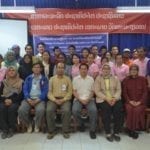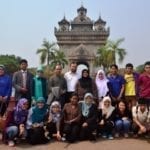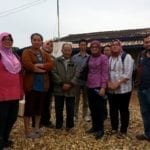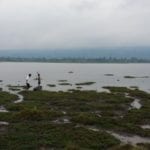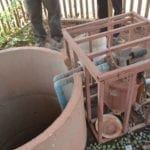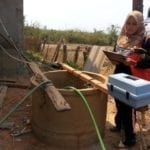20-24 March 2014 – A Delegation from UTM through the office of the Deputy Vice Chancellor of Student Affairs and Alumni (HEMA) and UTM-Community Transformation Centre visited Laos to continue the community water challenge engagement set in January 2014 with the Ministry of Health, Lao PDR.
This is part of the Cambodia, Laos, Myanmar, Vietnam (CLMV) grant provided by MOE to enhance Malaysia’s visibility in empowering nations within the region. This project contributes to the ASEAN Community Roadmap 2009-2015 in “Promoting sustainability of water resources to ensure equitable accessibility and sufficient water quantity of acceptable quality to meet the needs of the people of ASEAN”.
As part of the engagement in Nangungmay Village, Vientiane, 7 UTM researchers and 12 students, 13 University of Health Science Lao (UHS) students, 3 academics from UHS, and 4 researchers from the National Centre for Environmental Health and Water Supply, and 1 Australian NGO all worked hand in hand to practice collaborative innovation and the innovation systems methodology, skills for gathering information about the context of water challenges; and synthesized how a bevy of tools and methodologies can aid in creating collaborative research proposals with communities in Ban Na Ngom Village. The engagement coincides with the World Water Day on 22nd March, specifically, understanding another’s experience and beliefs without personal bias or assumptions via interview techniques designed to enable full understanding of the challenges affecting Ban Na Ngom villagers.
The UTM team together with the Lao counterparts, applied various approaches across multiple research areas such as water, capacity building, architectural and language. Several tools for water-related contexts such as e-Coli testing and water turbidity testing inclusive of potential capacity building and infrastructure development were leveraged accross UTM’s expertise.
The highly interactive and kickoff meeting began with an exploration of the villages key goals namely, increasing amount of water accessability and hygiene related matters. Speaking openly about these goals and why they were important oriented the entire group to the values of the community and enabled the creation of a shared vision of the goals to be attained and challenges to be overcome. The community members present agreed that reaching these goals would accomplish the following: 1) increase water accessibility; 2) allow the community to understand the location to place wells in communities; 3) create stronger awareness of water hygiene; 4) increase the number of community members concerned in water hygiene; and 5) make Ban Na Ngom Village a water accessible and hygienic village.
Breaking into three groups, UTM researchers facilitated further exploration of each goal and the creation of three unique “Shared Problem Statements.” Focusing on goals, challenges, and visions for solutions enumerated in the proposed goals of community engagement, the groups engaged in a process called “collaborative challenge”, to leverage critical bottlenecks to progress which, if not addressed, might stymie efforts to solve those challenges. In this step, community members, researchers, and students across UTM, UHS and Nam Saat identified a broad range of specific challenges that Ban Na Ngom Village and Nam Saat must tackle in the coming years.
The community and UTM identified areas of alignment between the challenges identified by the community and the competencies and passion of the researchers. Teams of community members and UTM researchers and students worked around the challenges of hygiene awareness; waste management; building of protective wells; providing sufficient water for drinking; and capacity building in schools.
Finally, outcomes of the engagement established the various situational analysis that led the Ban Na Ngom Na villages to understand more on their water-related conditions such as
i. wells to be built further away from village homes to reduce e-coli contamination;
ii. increased usage of bio-sand filters, sustaining water cleanliness;
iii. the village lake water can be used for drinking, provided it is filtered;
iv. protective wells to be built; and
v. capacity building in schools within the village.
These teams established paths for further inquiry and ongoing engagement with the goal of formulating draft collaborative proposals and solve challenges in the months ahead. The partnership is strengthened with opportunities and interest among UTM students to do internships in Laos through Nam Saat and vice-versa.
Photos


